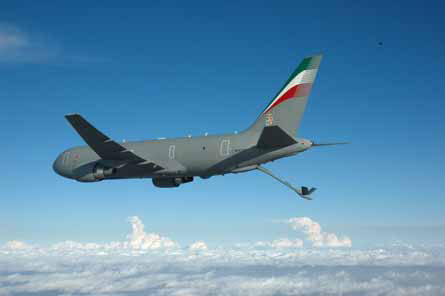A costly and unpopular war, a new balance of political power, a faltering economy at home and proliferating threats abroad - that is the stew from which this year's US defence budget will emerge.
Most pundits believe the Democrats, having taken control of Congress, will give the war-worn US military pretty much what it wants in the short term - at least until the presidential election in 2008. But the bills may have to be paid out of long-term re-equipment programmes.
|
|---|
Buying new tankers is a priority for the US Air Force |
The $447 billion fiscal year 2007 budget has barely begun to be spent, and already the services are looking at $170 billion in supplemental funding to cover war-related wear and tear on equipment. The Democrats do not like this "double-dipping" on funding, and plan to tighten controls on Pentagon spending, but have also said they will support the troops.
With the US economy slowing, raising the threat of growing deficits, Congress may not be able to meet the military's near-term needs and fund all its longer-term requirements. Key aviation modernisation programmes such as the Joint Strike Fighter could be vulnerable to the diversion of funds to more pressing needs.
Having secured the F-22 fighter last year, the US Air Force's priority for 2007 is getting its KC-X tanker replacement under way and starting work on a next-generation bomber - both programmes that will not bear fruit until the next decade. Congress is likely to vote money for more C-17 and C-130J airlifters, seeing them as more immediately useful in a war. But the funds will have to come from somewhere.
True to form
The JSF's vulnerability is the assumption, born of previous programmes, that it will be late, so funding can be delayed. So far this is running true to form. But one reason those previous programmes fell behind was the continuous trimming of budgets by Congress, so it is a self-fulfilling prophecy. And, after its first flight in December, the F-35 is finally gaining momentum which will be hard to recover if squandered by the services or Congress.
With the tanker and bomber programmes high on the USAF's priority list, they are likely to become the focus of any fight for funding this year. Meanwhile, both Boeing and Lockheed, having worked hard to keep their programmes alive last year, are likely to pressure Congress to keep the C-17 and C-130J lines open beyond the current horizon of 2009-10.
Any day now, the US Navy will publicly acknowledge a looming fighter shortfall caused by delays to the JSF, and unveil plans to buy up to 200 additional F/A-18E/F Super Hornets to fill the gap. The USAF could do the same, buying more F-15s or F-16s while the lines are still rolling for export customers, or asking for more F-22s to keep the line from closing.
Any of these actions will increase the pressure on a defence budget already stretched by the demands of operations in Iraq and Afghanistan. JSF was cut last year, by slowing initial production to two in FY07 and 12 in FY08. These cuts already make it impossible for the programme to achieve its planned ramp-up to 50 aircraft of all three versions in FY09.
Like circling predators singling out a weakened animal within a milling herd, lawmakers could consider another near-term cut to a long-term programme like JSF an easy option. But too many trimmings could soon see the F-35 trailing the group, costs spiraling as numbers drop, and vulnerable to a fatal blow.
Lockheed and its partners will have to work hard to keep the programme delivering on its promises - and hope lawmakers see that the war will end one day and US forces will have to look to their future.
Source: Flight International

















